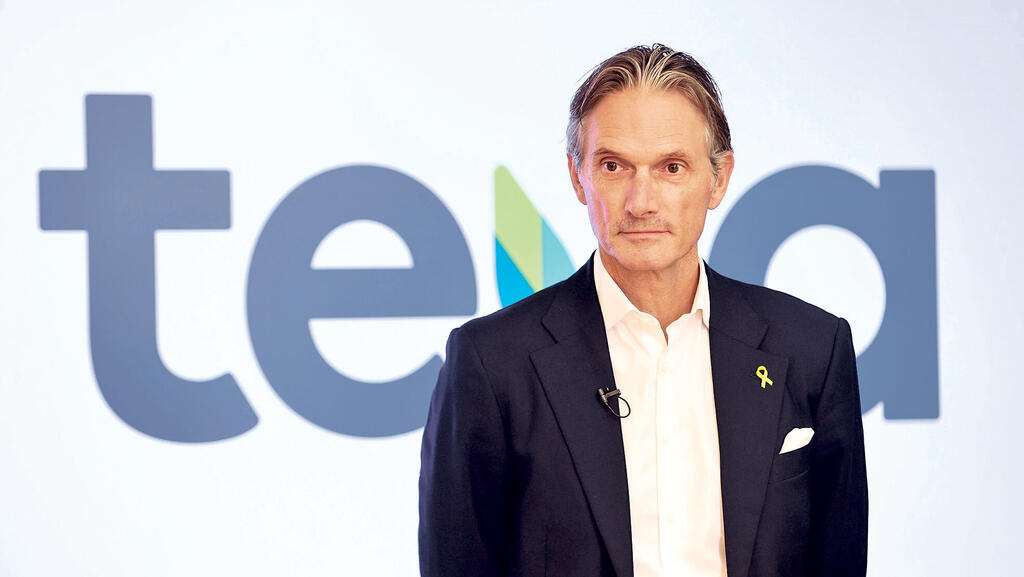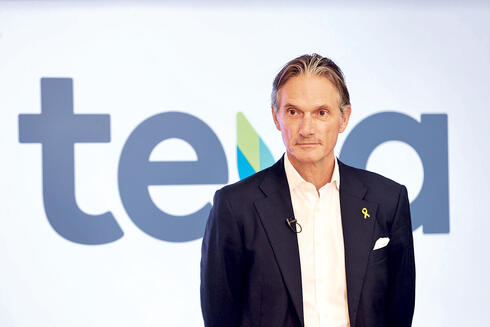
Teva’s quiet layoff announcement reveals bold restructuring plan
CEO signals this is ‘just the first step’ in multi-year effort to streamline and scale.
Teva Pharmaceuticals offered a long-awaited explanation for the sharp 10% jump in its share price last week. But the gains come at a steep human cost.
The Israeli drugmaker reassured investors with a revised, more optimistic profit forecast—after a previous one had triggered widespread concern and a selloff earlier this year. Yet buried deep in the investor presentation, almost as an afterthought on slide 15, Teva revealed that it plans to lay off 8% of its global workforce over the next 18 months.
That translates to nearly 3,000 job cuts from a total of 36,167 employees worldwide. In Israel, where Teva employs around 3,400 people, this could mean roughly 300 layoffs, assuming the cuts are evenly distributed.
The workforce reduction is part of CEO Richard Francis’ strategic overhaul, which aims to pivot Teva from a legacy generics manufacturer to a biopharmaceutical company focused on innovative drugs. The cuts will primarily hit logistics and procurement departments as the company seeks to streamline operations and eliminate duplication. R&D, by contrast, will be a growth area, according to management.
Officially, this is part of an “efficiency program” designed to generate $700 million in savings by 2027. But Chief Financial Officer Eli Kalif made clear on Tuesday that the pace of implementation will be faster than the timeline suggests.
“We’re facing global competition and want to become a biopharmaceutical company, not just a generics player,” Kalif told Calcalist. “This plan has been in the works for some time. As early as 2022, we set a goal of achieving 30% operating profit by 2027. Now it’s time to execute.”
Layoffs Amid Renewed Growth Ambitions
The company tried to temper the impact of the news. “We will make organizational adjustments to simplify work processes, eliminate duplication, and reallocate resources toward our growth engines,” Teva said in a statement. “That includes investment in R&D, strategic processes, and our global innovation program, which will be based in Israel.”
The announcement comes after several years of relative labor stability following massive cuts in 2018, when Teva laid off a quarter of its workforce and shuttered major operations in Israel, including facilities in Kiryat Shmona and Jerusalem. Today, Teva’s Israeli workforce is more focused on research and development, though the company still maintains five sites: its headquarters in Kiryat Atidim, a logistics hub in Shoham, a manufacturing facility in Neot Hovav (now up for sale), and two R&D and production sites in Netanya and Kfar Saba.
Francis emphasized that this is only the beginning. “This is a journey, not a one-time target,” he said. “We constantly need to rethink how Teva allocates capital to accelerate growth. This is the first major step, but there will be more. For example, we currently operate 35 manufacturing sites globally and aim to reduce that number to 30 by 2027.”
While employees were understandably shaken, investors welcomed the clarity on the company’s cost-cutting plans. Teva shares jumped 9% on Tuesday, lifting its market capitalization back above $20 billion.
Investor anxiety has been heightened not only by earlier missed targets, but also by recent news that Revlimid—one of Teva’s most profitable generics—is expected to see sharp price declines. Revlimid, used to treat myeloma, generated over $1 billion in revenue and $700 million in profit for Teva in 2024.
Until now, a settlement between Teva and rival firms had protected its slice of the Revlimid market from new competition. That deal expires in 2026, opening the door to a flood of new generic entrants and putting downward pressure on pricing. Kalif acknowledged that some of the new layoffs are meant to preemptively offset this coming revenue decline.
Despite these headwinds, Teva said it expects EBITDA in 2026 to grow relative to 2025. But it’s clear the coming years will be marked by continued restructuring and uncertainty.
First-Quarter Results Beat on Profit, Miss on Revenue
In the first quarter of 2025, Teva delivered mixed results. Revenue came in at $3.9 billion—$100 million short of expectations and up just 5% year-over-year. But profit beat forecasts, with earnings of $0.52 per share versus Wall Street expectations of $0.48.
Austedo, Teva’s flagship treatment for tardive dyskinesia, continues to be the company’s top growth engine. The drug posted $411 million in revenue, up 39% from a year ago, prompting Teva to raise its full-year sales forecast for Austedo to between $1.95 billion and $2.05 billion.
Ajovy, Teva’s migraine drug, also performed well, with revenue climbing 26% to $139 million.
Meanwhile, Teva’s generics division—still the company’s largest—grew 3% to $2.3 billion. That figure reflects a mixed bag: declining legacy products like Copaxone weighed on performance, while newer generics and biosimilars provided a modest lift. The company aims to gradually reduce the generics segment's share of its revenue mix.
Related articles:
Francis unveiled additional elements of Teva’s long-term vision this week. Beyond Austedo, the company is betting on two new proprietary drugs—Uzedy and Olanzapine—for the treatment of schizophrenia.
Teva is also in late-stage clinical trials, alongside French pharmaceutical giant Sanofi, on Duvakitug, a new treatment for Crohn’s disease and colitis. If successful, it could become Teva’s next Copaxone.
To support its strategic pivot, Teva raised its annual revenue forecast to between $16.8 billion and $17.2 billion, up by $200 million. The company also increased its operating profit guidance by the same amount, now expecting between $4.3 billion and $4.6 billion. Notably, these figures do not yet include potential milestone payments from Sanofi tied to Duvakitug’s progress.
Still, the company continues to carry significant debt—$15 billion as of the end of Q1 2025. Teva is also in the advanced stages of selling its active pharmaceutical ingredients division, which generates $500 million in annual revenue but shows little growth. Market expectations had called for a quicker deal, but the company said the process is progressing.
alif made clear on Tuesday that the pace of implementation will be faster than the timeline suggests.“We’re facing global competition and want to become a biopharmaceutical company, not just a generics player,” Kalif told Calcalist. “This plan has been in the works for some time. As early as 2022, we set a goal of achieving 30% operating profit by 2027. Now it’s time to execute.”
Layoffs Amid Renewed Growth Ambitions
The company tried to temper the impact of the news. “We will make organizational adjustments to simplify work processes, eliminate duplication, and reallocate resources toward our growth engines,” Teva said in a statement. “That includes investment in R&D, strategic processes, and our global innovation program, which will be based in Israel.”
The announcement comes after several years of relative labor stability following massive cuts in 2018, when Teva laid off a quarter of its workforce and shuttered major operations in Israel, including facilities in Kiryat Shmona and Jerusalem. Today, Teva’s Israeli workforce is more focused on research and development, though the company still maintains five sites: its headquarters in Kiryat Atidim, a logistics hub in Shoham, a manufacturing facility in Neot Hovav (now up for sale), and two R&D and production sites in Netanya and Kfar Saba.
Francis emphasized that this is only the beginning. “This is a journey, not a one-time target,” he said. “We constantly need to rethink how Teva allocates capital to accelerate growth. This is the first major step, but there will be more. For example, we currently operate 35 manufacturing sites globally and aim to reduce that number to 30 by 2027.”
While employees were understandably shaken, investors welcomed the clarity on the company’s cost-cutting plans. Teva shares jumped 9% on Tuesday, lifting its market capitalization back above $20 billion.
Investor anxiety has been heightened not only by earlier missed targets, but also by recent news that Revlimid—one of Teva’s most profitable generics—is expected to see sharp price declines. Revlimid, used to treat myeloma, generated over $1 billion in revenue and $700 million in profit for Teva in 2024.
Until now, a settlement between Teva and rival firms had protected its slice of the Revlimid market from new competition. That deal expires in 2026, opening the door to a flood of new generic entrants and putting downward pressure on pricing. Kalif acknowledged that some of the new layoffs are meant to preemptively offset this coming revenue decline.
Despite these headwinds, Teva said it expects EBITDA in 2026 to grow relative to 2025. But it’s clear the coming years will be marked by continued restructuring and uncertainty.
First-Quarter Results Beat on Profit, Miss on Revenue
In the first quarter of 2025, Teva delivered mixed results. Revenue came in at $3.9 billion—$100 million short of expectations and up just 5% year-over-year. But profit beat forecasts, with earnings of $0.52 per share versus Wall Street expectations of $0.48.
Austedo, Teva’s flagship treatment for tardive dyskinesia, continues to be the company’s top growth engine. The drug posted $411 million in revenue, up 39% from a year ago, prompting Teva to raise its full-year sales forecast for Austedo to between $1.95 billion and $2.05 billion.
Ajovy, Teva’s migraine drug, also performed well, with revenue climbing 26% to $139 million.
Meanwhile, Teva’s generics division—still the company’s largest—grew 3% to $2.3 billion. That figure reflects a mixed bag: declining legacy products like Copaxone weighed on performance, while newer generics and biosimilars provided a modest lift. The company aims to gradually reduce the generics segment's share of its revenue mix.
Related articles:
Francis unveiled additional elements of Teva’s long-term vision this week. Beyond Austedo, the company is betting on two new proprietary drugs—Uzedy and Olanzapine—for the treatment of schizophrenia.
Teva is also in late-stage clinical trials, alongside French pharmaceutical giant Sanofi, on Duvakitug, a new treatment for Crohn’s disease and colitis. If successful, it could become Teva’s next Copaxone.
To support its strategic pivot, Teva raised its annual revenue forecast to between $16.8 billion and $17.2 billion, up by $200 million. The company also increased its operating profit guidance by the same amount, now expecting between $4.3 billion and $4.6 billion. Notably, these figures do not yet include potential milestone payments from Sanofi tied to Duvakitug’s progress.
Still, the company continues to carry significant debt—$15 billion as of the end of Q1 2025. Teva is also in the advanced stages of selling its active pharmaceutical ingredients division, which generates $500 million in annual revenue but shows little growth. Market expectations had called for a quicker deal, but the company said the process is progressing.
